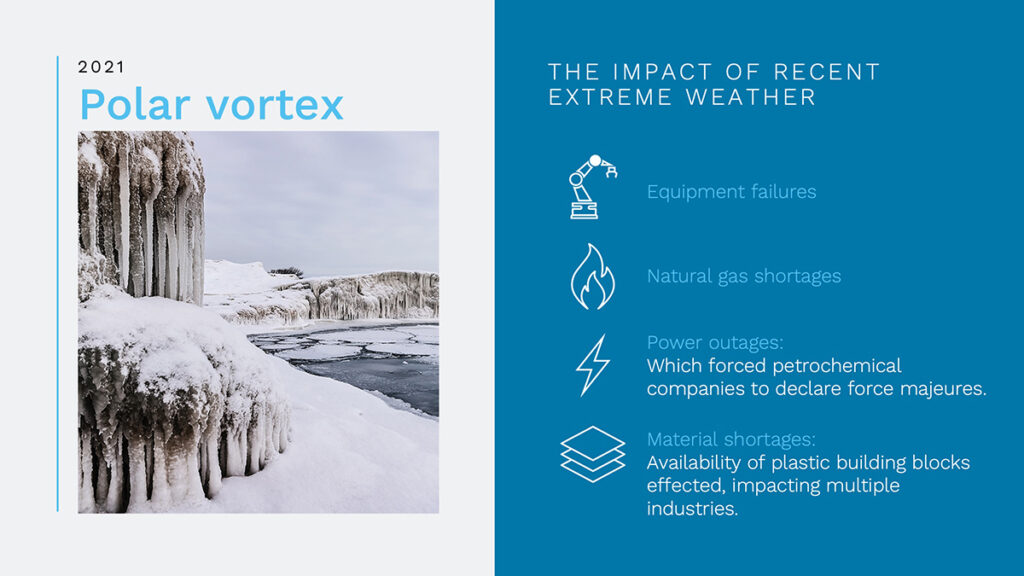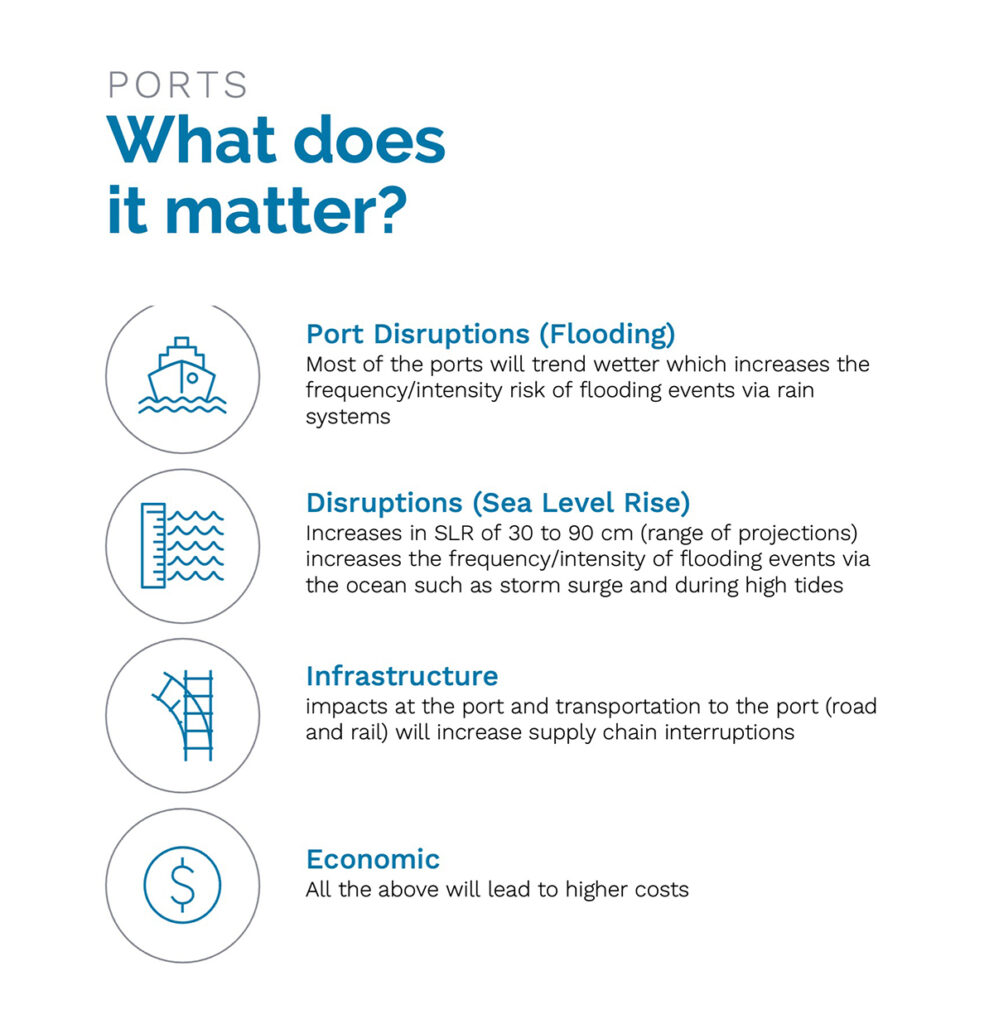Extreme weather is becoming the norm across the world, and effective climate risk management will have a direct impact on your supply chain. From devastating droughts to sudden floods, from higher temperatures to polar vortexes, climate change will continue to disrupt supply chains, costing organizations a significant amount of time and money.
That’s why climate risk management is key to building a resilient supply chain. Relying on short-term regional weather forecasts won’t suffice anymore. Instead, advanced weather modeling and predictive analytics will help organizations understand how climate change is impacting supply chains now and decades into the future.

Figure 1: Climate risk management can mitigate growing economic losses due to extreme weather events.
Rising temperatures and increased precipitation are just two climate-related risks that are costing supply chains billions of dollars. Using the latest weather modeling from applied meteorologists, we now have insights into what our climate could be like in the next 30 years, and how these issues could cause complications to business operations around the world.
Applied meteorology for climate risk management
With advanced modeling and predictive analytics, applied meteorology teams can provide accurate forecasting for extreme weather incidents, as well as a range of possibilities for climate-related changes, such as increased heat or rain levels. By understanding climate risks within their global supply chains, organizations can make proactive decisions, minimizing disruptions and delays from weather events such as droughts, floods, and more.
Applied meteorologists don’t only keep their eyes on the sky. They can also provide insight into other relevant climate-related challenges, including corn pollination and cattle movement. This holistic overview into climate risks will give organizations competitive advantage, allowing them to adjust supply chains early, and ward off large disruptions due to seemingly small events.
Applied meteorology will be critical in creating a resilient supply chain as climate risks continue to grow, so ensure your organization has access to applied meteorology and advanced climate forecasting.
More climate risk extremes
It’s not just droughts that will threaten supply chains; there’s no doubt that extreme weather across every category is increasing. According to the UN, the number of extreme weather events that occurred in 1980-1999 almost doubled in 2000-2019, leading to economic losses of $2.97 trillion, an 83% increase. The effects of climate shifts aren’t siloed; as supply chains are more global than ever, powerful hurricanes and other weather events halfway across the world can have major impacts, causing complicated and expensive disruptions.
For example, last year’s drought in Europe created pass-along effects around the world, keeping popular consumer food items off the shelves as businesses struggled to pivot to other suppliers and ensure rapid transportation to minimize delays.

Figure 2: Extreme weather events damage business operations in multiple ways, creating a pressing need for climate risk management.
Climate risk management will be key to building a resilient supply chain, even if the weather events themselves are unavoidable. Armed with advanced analytics and Artificial Intelligence that provide real-time, constant monitoring, organizations can now prepare effectively for droughts, increased rainfall, and other climate events. By understanding the climate risks inherent in your supply chain (including your sub-tier suppliers) using digital mapping and predictive insights, organizations can take preventive actions to lessen the effects of climate events.
Flood risk rises
Ironically, both drought and flooding are increasing across the world. Drier climates are becoming even more parched, with droughts and low water levels setting records each year.
Meanwhile, in wetter climates, precipitation levels are escalating. Rising sea levels and extreme weather combine to create an increase in flooding events. Between 2020 and 2050, 22 out of the 25 top global ports will experience an increase in rain, potentially throwing shipping flows into disarray. Without careful planning, even the ports that will get drier over time face disruptions as local teams and supply chain management teams work to adjust to these new conditions.

Figure 3: Baseline annual precipitation is already high for some climates in 2020.
Rising sea levels and an increase in flooding events doesn’t exactly spell good news for working ports, which will have to ensure that their infrastructure is strong enough to withstand intense inundations, storm surges, and high tides. Higher precipitation will also disrupt transportation within and to ports by rail and road, as their respective infrastructures are also damaged by water damage and flooding. It is easy to see how these factors will not only lead to weather-related delays, but also to increased costs as ports go dark to conduct repairs or as organizations look for alternate ports to ship to and from.

Figure 4: Advanced meteorology modeling shows increase in annual precipitation by 2050.

Figure 5: Many ports will see over 100-millimeter increases in precipitation by 2050.
2050 may seem very far away, but the fact is we’re already seeing the beginning of this shift in climate extremes. Understanding and keeping these changes in mind when considering supply chain risk management now will allow organizations to make deliberate, proactive choices over a longer period, instead of rushed, desperate decisions.
Case Study: Climate risk management in action
A medical technology company began tracking climate risk after several major climate disruptions, including Hurricane Maria and several wildfires. Originally, they wanted to be able to have some idea of the potentially damaging climate events that could affect their operations to be able to implement mitigation strategies.
After a few years of monitoring their climate risk, they were not only able to successfully execute their risk management strategies, but also felt empowered to begin improving their supply chain from a sustainability perspective. Now, they can actively visualize their climate risks. The company’s supply chain executives are now working with Everstream’s applied meteorology and climate team using modeling to become carbon neutral within the next decade.
Red skies at dawn, sailors be warned
There is no doubt that climate risks will impact supply chain operations over the next 30 years; even the best-case weather models show drastic increases in extreme weather around the world. Therefore, climate risk management will be critical to successful supply chain risk management and must not be ignored.

Figure 6: Failures in climate risk management will lead to economic and infrastructure disruptions at world ports.
Luckily, applied meteorology teams are on hand to model and discuss potential forecasts, alternatives, and solutions as we look into the future. Cutting-edge, advanced weather analytics are also critical in mapping out different scenarios, so organizations can be as prepared as possible for tomorrow’s climate risks.
Don’t wait for cloudy skies – take control of your climate risk management today.
Watch our webinar to see how climate’s new Era of Extremes will affect your supply chain